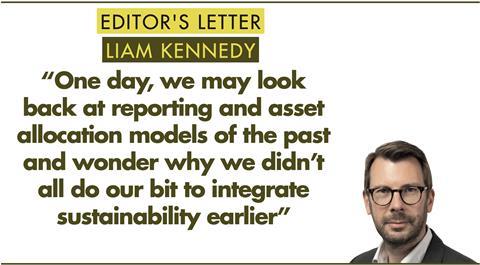For years, strategic asset allocation (SAA) has been a cornerstone of investment for pension funds and other institutional investors. Is sustainability a missing ingredient?

Gary Brinson, value investing proponent and founder of Brinson & Partners, later acquired by UBS, plays a strong part in the development of thinking around SAA as co-author of a seminal paper of 1986 together with Randolph Hood and Gilbert Beebower.
In ‘Determinants of portfolio performance’, Brinson and his co-authors sought to attribute returns to the most relevant activities – asset allocation, manager selection, security selection or market timing.
Their core finding was that asset allocation is the primary determinant of the variability of returns in a portfolio.
Many people have misinterpreted the Brinson findings to claim that asset allocation “determines” or is “responsible” for over 90% of a portfolio’s return.
That in turn led indirectly to dubious claims in marketing material by asset managers and consultants that adding one product or another – often hedge funds or private equity – would boost long-term returns.
One important challenge to the Brinson study was from William Jahnke in 1997, who criticised the focus on returns variability and argued that investors should be more concerned with the range of outcomes than the volatility of returns. This more adaptive approach in turn laid the ground for more scenario-based thinking in asset allocation.
In 2019, Kees Koedijk, Alfred Slager and Jaap van Dam, all heavy hitters in the Dutch pension scene, published the handbook Achieving Investment Excellence, which was aimed at trustees and other asset allocators. It speaks for the importance of governance in determining asset allocation, and the need for adaptive thinking in response to changing market conditions.
In the post-financial crisis low-rate environment, real assets and private markets became much more accessible, allowing more pension funds to gain exposure to areas like infrastructure debt and private credit.
At the same time, sustainability and ESG have become more embedded in the management of pension funds – at one point through exclusions and now through a variety of approaches including passive strategies rooted in scoring systems and the increased use of carbon-reducing strategies.
The concept of double materiality requires corporates and investors to establish and manage their sustainability impacts on the wider world as well as on their own activities or portfolios.
For Prof Dirk Schoenmaker, investment committee chair at the Dutch pension fund PFZW and professor of banking and finance at Erasmus University’s Rotterdam School of Management, it would be a mistake to regard sustainability in isolation or as an afterthought.
Following his appointment to the board of PFZW in 2022, the pension fund and its asset manager PGGM have sought to integrate risk, return and sustainability within PFZW’s portfolio. They can point to success in areas like direct property, where sustainability is embedded in the investment process.
Schoenmaker is co-author of a 2024 working paper titled ‘An integrated strategic asset allocation framework’, in which he and his co-authors propose that impact (as in the impact of the portfolio on the real world and its sustainability rather than just the UN-SDGs) should be integrated into asset allocation early on.
Most of the inputs to a traditional strategic asset allocation are clear: asset class volatilities and index and portfolio return data over time. Embedding sustainability in the process begs the immediate question – what data, how much of it and how much is available?
Schoenmaker points to the Science Based Targets and the Transition Pathway initiatives. ESG scores are a flawed mechanism, he believes; while the creation of perfect versions of them may be an elusive goal, they can be improved upon.
Corporates play a role as key drivers of the investment and innovation needed to drive the energy, agricultural and ecosystem transition – and as sources of data. Hence the importance of regulation such as the EU’s CSRD reporting regulation.
If Schoenmaker is to be believed, we may be in the foothills of another transformation in the way pension funds and long-term investors think about sustainability.
It is unlikely that integrated SAA will take off immediately. The obstacles are real and the exercise only makes sense if you believe everyone will get behind it – governments, corporates, lenders and investors.
Schoenmaker offers hope. One day, we may look back at reporting and asset allocation models of the past and wonder why we didn’t all do our bit to integrate sustainability earlier.
Liam Kennedy, Editor, IPE
+liam.kennedy@ipe.com

























No comments yet